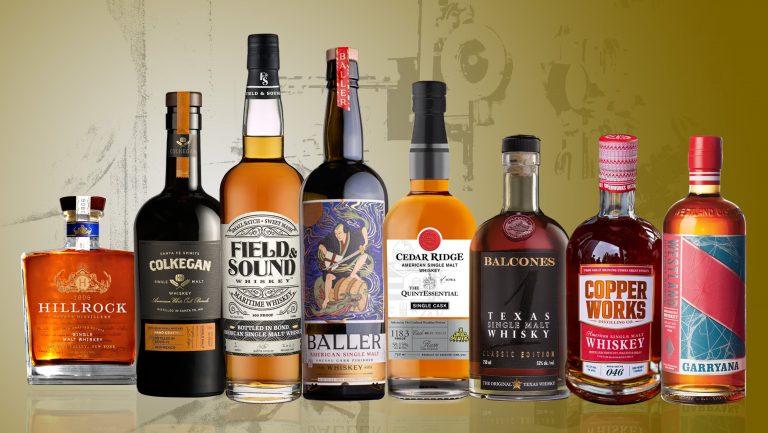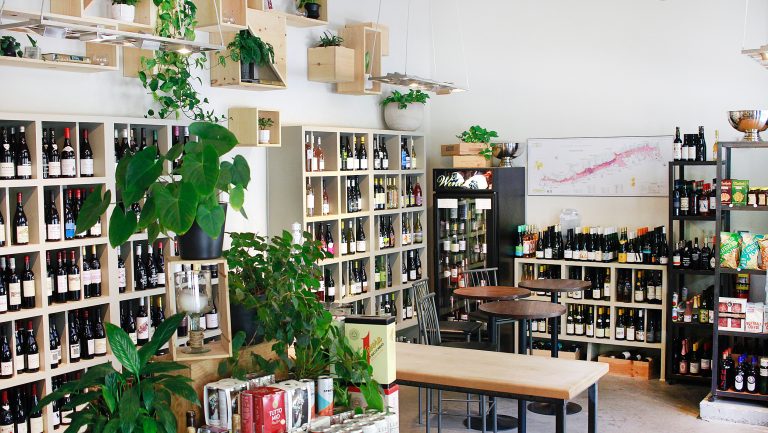When I first opened my wine shop, Domaine LA, it was 2009, at the height of the recession. Consumers were scaling back, and gone were the days when $40 was normal for a weekday bottle. Having a bootstrapped business, I also had a limited amount of money to buy inventory. As a result, the Los Angeles shop filled up with bottles that were less than $20, and these wines—budget-conscious but still made with integrity—are something Domaine LA is now known for.
Even though such bottles are located throughout the store, the wall leading from the front door to the cash counter, about 25 feet long, is known as The Wall of Affordable Deliciousness, as announced by the chicken-scrawl title written on the chalkboard above it. Comprising about 15 case stacks of $15-and-under essentials, these are wines for the dinner table, parties, gifts, and Wednesday nights.
I think it’s safe to say that my store isn’t alone; budget bottles for everyday drinking often make up the lion’s share of specialty wine shop sales. Whether it’s a wall leading to the cash wrap, a table featuring bargains, or end caps with case stacks, nearly every shop I’ve been in features these wines prominently, and customers are well served by these value centers.

Don’t miss the latest drinks industry news and insights. Sign up for our award-winning newsletters and get insider intel, resources, and trends delivered to your inbox every week.
Perhaps a third of all bottles sold at Domaine LA come from the front wall, which equates to a significant percentage of revenue. Customers who shop from this selection buy not just one bottle but generally four or more. With regularity, a customer who tries a bottle from the wall will return for a half dozen additional bottles of that same wine—often a case. Repeat business is significant, and it’s easy to tell after a week’s trial if we’ll move volume of a given wine or not.
Maybe most importantly, though, the wall is a great jumping-off point for customers: If they shop there first and learn to trust our selections, they’ll more confidently and comfortably venture throughout the rest of the store when they want a higher-priced wine. For any shop, I believe the budget bottle is where trust and loyalty are built and solidified. It’s the equivalent of a restaurant’s by-the-glass program, and the way we buy for our wall is very similar to the way a restaurant might select its glass pours.
While there are tons of industrial inexpensive wines available in the marketplace, those aren’t the wines I’m looking for. I have delineated criteria that all of the wines in the shop—even the bargains—have to live up to. The wines on the wall are typically from smaller producers (though they might be larger production bottlings from those producers), preferably made from organically farmed grapes that are fermented with indigenous yeasts. They’re approachable stylistically while still interesting. Factoring in these criteria, my options become more limited, which means finding wines that belong on the wall often takes much more work than other areas of the store. I really have to hunt.
Over the past eight years, I’ve devised a method to the madness. I have certain categories that I always like to hit and other guiding principles for how I fill the slots. Here are my tips for designing a very active, affordable wine wall.
Tips for Designing a Successful Wine Wall
Change Things Up
Keep the budget bottles fresh and rotating. But also be mindful that a lot of people like continuity, especially at this price point. Sometimes we get very limited amounts of wines that only stay on the wall for a month, and sometimes we have things that remain for years. Having a balance of both is tricky but important.
Include a Couple of Funkier, More Natural Items
It can be hard to fit the $15-and-under price point with this, but as long as you let people know that what they’re buying is a little more unusual, the cost of entry is reasonable and it can lead to people getting more curious about these wines in general.
Plant Bargains throughout the Store
If a wine is successful on the wall but has lived there a little too long, it might find a home with its pricier siblings on the fancier shelves. And sometimes these are wines that have never been on the wall. With the former, a customer might migrate with their chosen wall bottle and get comfortable shopping throughout the store. In this way, they’ll find that wine isn’t all that intimidating, from either an intellectual or a cost perspective.

5 Wine Shop Instagram Accounts to Follow
From capturing tasting notes visually to using double magnums as peg legs, these retailer feeds stand apart
Wines for the Wall of Affordable Deliciousness
Here are the categories of wine I like to keep around:
Liter Bottles
I always have a Grüner liter on the wall. They’re literally more wine for your money and are great for parties, since people are always fearful of running out. In addition to Austrian Grüner Veltliners, an increasing number of interesting and offbeat liters (Barbera from Piedmont, Gamay from the Loire Valley) are making appearances now. The Poderi Cellario È Rosso and Hervé Villemade’s Bovin Blanc and Rouge are a few of my current favorites.
Fuller Whites
While we love high-acid, lean whites at Domaine LA, we also need to service clients looking for richer wines. When Chardonnay fills this spot, it’s often something like the Foxglove Central Coast, one of the few budget-conscious small-production domestic wines. Folk Machine’s Chenin Blanc is a nice alternative to Chardonnay.
Sparkling Wine
We’ll always have something sparkling that’s good on its own but also good for mimosas and such. Mercat Cava is a terrific, traditional-method bubbly that does both of these things, as is the Collin Blanc Crémant from Limoux.
Spectrum of Reds
I try to offer red options that range from light and chillable to fuller and meaty, as well as a wine to go with pizza. You know, the essentials! Marcel Lapierre’s Raisins Gaulois, Les Hérétiques from Château d’Oupia, and Domaine la Manarine Côtes du Rhône go from one extreme to the other.
Muscadet
Muscadet is my secret weapon. This region offers some of the best affordable wines in the world. Producers like Vincent Caillé, J. Mourat, and Domaine de la Pépière all have bottles that retail for $15 or less. Is there a better bottle of white wine at $15 than the classique from Pépière? It’s unlikely.
Private Labels from Importers
I’ve found a few ambitious and younger importers working with their growers to create penny-wise private labels that, while they might be made from purchased fruit, still retain character of place and the producer’s style. The Boutanche series from Selection Massale is a case in point, as is the Popolo from Indie Wineries.
Pinot Alternatives
It’s truly difficult to find great examples of Pinot Noir at $15 or less, so we often have a wine that’s under the heading, “Try this instead of Pinot Noir!” And because people trust us, they do. And they end up with an introduction to interesting grapes like Grignolino and Pais that give them far more bang for their buck.
Food Pairings and Seasonal Bottles
For summer, we might add a second or third rosé stack (let’s be real, we feature rosé year-round in Domaine LA). Around Thanksgiving we have a turkey wine, and all year long we suggest something to go with pizza. We don’t even need words to describe or sell these wines—something as simple as an emoji of a slice might do.

Dispatch
Sign up for our award-winning newsletter
Don’t miss the latest drinks industry news and insights—delivered to your inbox every week.
After working in the film industry for more than a decade, Jill Bernheimer accidentally transitioned to the wine business, starting a wine blog and shop that eventually became the brick-and-mortar store, Domaine LA.







